
Amaryllis is the only genus in the subtribe Amaryllidinae. It is a small genus of flowering bulbs, with two species. The better known of the two, Amaryllis belladonna, is a native of the Western Cape region of South Africa, particularly the rocky southwest area between the Olifants River Valley and Knysna.

Narcissus is a genus of predominantly spring flowering perennial plants of the amaryllis family, Amaryllidaceae. Various common names including daffodil, narcissus, and jonquil are used to describe all or some members of the genus. Narcissus has conspicuous flowers with six petal-like tepals surmounted by a cup- or trumpet-shaped corona. The flowers are generally white and yellow, with either uniform or contrasting coloured tepals and corona.
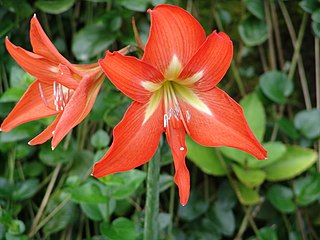
Hippeastrum is a genus of about 90 species and over 600 hybrids and cultivars of perennial herbaceous bulbous plants. They generally have large fleshy bulbs and tall broad leaves, generally evergreen, and large red or purple flowers.
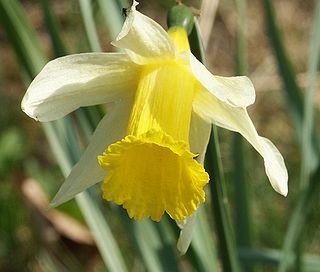
Narcissus pseudonarcissus is a perennial flowering plant.
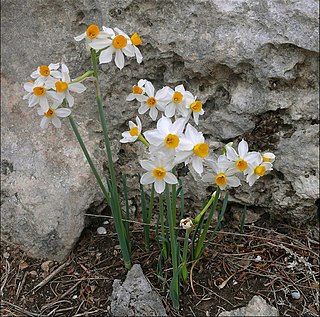
Narcissus tazetta is a perennial ornamental plant that grows from a bulb. Cultivars of N. tazetta include 'Paperwhite', 'Grand Soleil d'Or' and 'Ziva', which are popularly used for forcing indoors, as is the form of N. tazetta known as Chinese Sacred Lily.

Lycorine is a toxic crystalline alkaloid found in various Amaryllidaceae species, such as the cultivated bush lily, surprise lilies (Lycoris), and daffodils (Narcissus). It may be highly poisonous, or even lethal, when ingested in certain quantities. Regardless, it is sometimes used medicinally, a reason why some groups may harvest the very popular Clivia miniata.

Zephyranthes robusta, synonym Habranthus robustus, commonly known as the Brazilian copperlily, pink fairy lily or the pink rain lily, is a species of herbaceous flowering bulb. It is native to Brazil, Argentina and Uruguay, but is now naturalized in Florida, Colombia, South Africa, and Mauritius.

Narcissus triandrus, also known as the Angel's Tears daffodil, is a species of dwarf flowering plant within the family Amaryllidaceae.

Pancratistatin (PST) is a natural compound initially extracted from spider lily, a Hawaiian native plant of the family Amaryllidaceae (AMD).
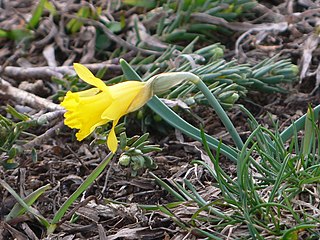
Narcissus asturiensis, the pygmy daffodil, is a perennial bulbous plant native to the mountains of North Portugal and Spain, where it grows at altitudes up to 2000 m (6000 ft). As of March 2022, Kew sources consider the correct name to be Narcissus cuneiflorus.

Boophone is a small genus of herbaceous, perennial and bulbous plants in the Amaryllis family It consists of two confirmed species distributed across South Africa to Kenya and Uganda. It is closely related to Crossyne, a genus whose species have prostrate leaves. They are drought tolerant but not cold-hardy, and are very poisonous to livestock.

The Amaryllidaceae are a family of herbaceous, mainly perennial and bulbous flowering plants in the monocot order Asparagales. The family takes its name from the genus Amaryllis and is commonly known as the amaryllis family. The leaves are usually linear, and the flowers are usually bisexual and symmetrical, arranged in umbels on the stem. The petals and sepals are undifferentiated as tepals, which may be fused at the base into a floral tube. Some also display a corona. Allyl sulfide compounds produce the characteristic odour of the onion subfamily (Allioideae).

4-Methylcatechol is a chemical compound. It is a component of castoreum, the exudate from the castor sacs of the mature beaver.

Hippeastrum calyptratum is a flowering perennial herbaceous bulbous plant, in the family Amaryllidaceae, native to Brazil.

Hamayne is an alkaloid present in plants of the family Amaryllidaceae, including Iberian Narcissus species and two Nigerian Crinum species, reported to have acetylcholinesterase inhibitory activity. The product has been made via total synthesis as well.

Narcisseae is a small tribe of plants belonging to the subfamily Amaryllidoideae of the Amaryllis family (Amaryllidaceae), where it forms part of the Eurasian clade, and is one of three tribes in the European (Mediterranean) clade. It contains two genera and approximately 58 species, but probably also Lapiedra. The two genera are distinguished from each other by the presence of a paraperigonium in the former.
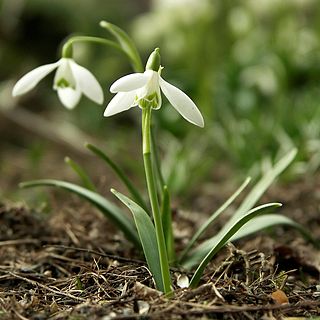
Galantheae is a tribe of plants belonging to the subfamily Amaryllidoideae of the Amaryllis family (Amaryllidaceae). As of 2017, it contains three genera, although more were included previously. The position of the ovary is inferior.

The taxonomy of Narcissus is complex, and still not fully resolved. Known to the ancients, the genus name appears in Graeco-Roman literature, although their interest was as much medicinal as botanical. It is unclear which species the ancients were familiar with. Although frequently mentioned in Mediaeval and Renaissance texts it was not formally described till the work of Linnaeus in 1753. By 1789 it had been grouped into a family (Narcissi) but shortly thereafter this was renamed Amaryllideae, from which comes the modern placement within Amaryllidaceae, although for a while it was considered part of Liliaceae.
Nina Rønsted is a Danish botanist, who is Director of Science and Conservation at The National Tropical Botanical Garden, Hawaii.

Cliviinae is a small subtribe of Haemantheae, and therefore within the African clades of Amaryllidoideae. It consists of two genera, Clivia, and Cryptostephanus.

















